Yes: this is the second review I’ve written for Annihilation. Yes: I’m aware that this is unnecessary and self-indulgent. Yes: people in my life are getting tired of hearing me talk about this movie. No: I can’t help myself. Warning: spoilers abound in this analysis of Alex Garland’s newest film. For a spoiler-free piece on the film, see my earlier post. If this movie is still somehow playing in a theater near you (and you live in one of the three countries where this is even possible), stop reading and go see it. If you watch it at home, turn the volume up.
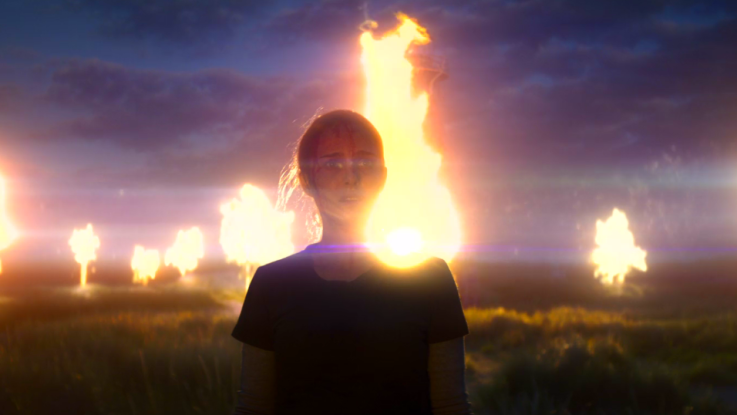
There is a tense and quietly symbolic moment in the early scenes of Alex Garland’s expansive sci-fi thriller Annihilation which hints at revelations yet to come in a film which methodically and at times jarringly breaks down our sense of reality as it winds on (and inward) like the river in Joseph Conrad’s Heart of Darkness.
Natalie Portman plays the central character in Annihilation; she is a biologist and professor who is at once poised and emotionally traumatized following the disappearance of her husband Kane (played by Oscar Isaac) during a mysterious military deployment over a year ago. When he returns quite suddenly one night her shock and relief fades as she questions him about where he was and how he got back. Her frustration rises as he is able to give her very little back; he seems himself to be in a state of deep confusion. His demeanor is strangely staid, his gaze frighteningly vacant.
In front of him on the kitchen table sits a glass of water.
Portman’s character Lena sits down in front of him and reaches out her hand – as their fingers intertwine the camera focuses closely on the glass of water. We see a closeup of their fingers refracted through the liquid, as her hands plead for a sense of warmth, a sign of human familiarity.

It won’t mean much to viewers at that moment, but this is an important glass of water. Rather, it is an important moment of foreshadowing for some truly strange revelations down the pipeline. Later, Lena will take a drink from a visually identical glass of water as she is being questioned about what the actual hell just happened in The Shimmer. This simple symbolism touches on multiple crucial themes of the film – doubling, fluidity, refraction – and speaks to the punctilious nature of the film’s ambitious script.
Lena’s answer to many of the questions thrown her way may echo the sentiments of many digesting this movie for the first time: “I don’t know.”
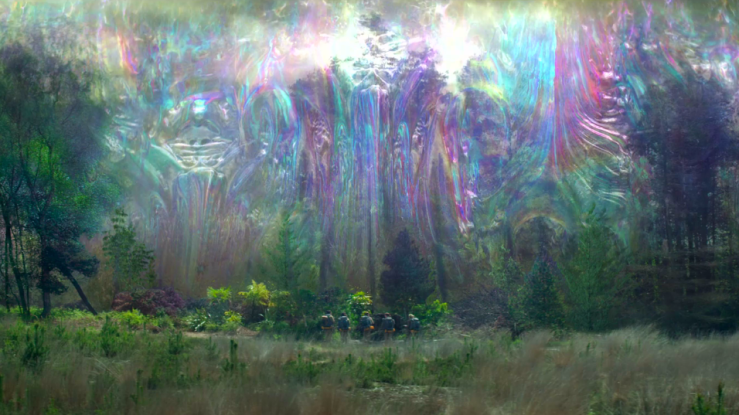
The ever-expanding Shimmer which grows outward from a coastal Lighthouse in Florida is represented as a monolithic, undulating rainbow of colors, like an alien soap bubble or ballooning oil slick. The five-person team of female scientists slip through its glistening border without issue, but inside The Shimmer it becomes clear that nothing is quite the same.
Through the thick canopy of dense foliage, light from the afternoon sun glimmers in a rainbow refraction of light waves – a beautiful effect which is repeated endlessly and increasingly as they head ever deeper into the park surrounding the Lighthouse. A giant albino alligator which attacks their group has rows of concentric teeth like that of a shark. A wild outgrowth of endlessly mutating flowers looks like dozens of different species – all growing from the same plant. Time itself seems warped, and weeks pass like days.

It is the physicist Josie (Tessa Thompson) who lands first on an explanation for what is happening in The Shimmer. When they come across an overgrown colony peppered with humanoid floral structures, she listens again to the scrambled sounds of the radio and lights upon an epiphany.
“The Shimmer is a prism,” she says in astonishment, “but it refracts everything. Not just light and radio waves: animal DNA, plant DNA, all DNA.”
“She’s talking about our DNA,” says the psychologist Dr. Ventress (Jennifer Jason Leigh) to the skeptical and increasingly paranoid paramedic Anya, played by Gina Rodriguez. “She’s talking about us.”

So Annihilation is, on at least one level, about mutation. And in this sense it is undeniably, as many have pointed out, about cancer. The very first scene of the film takes place in Lena’s classroom, as her students watch cervical cancer cells divide and multiply. Later, Lena relates the beautiful but boundless growth in The Shimmer to that of a tumor. Dr. Ventress’ strangely disaffected attitude in the face of unbelievable strangeness turns out to be in fact a response to her own cancer diagnosis. Lena is seen during a flashback reading The Immortal Life of Henrietta Lacks, by Rebecca Skloot. It is a nonfiction book about a black woman known to scientists as HeLa: her “immortal” line of cancer cells led to civilization-changing revelations in medicine, all without the knowledge or consent of her family. A multi-million dollar medical industry arose from her cells, while her body lay in an unmarked grave and her children lacked access to health care. It is a true story about science and race, death and immortality. Everything in this movie has intent.
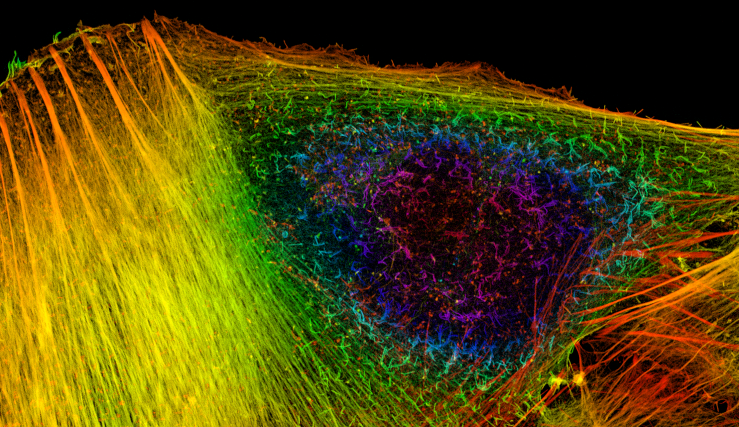
Whatever fell out of the sky onto the Lighthouse acts like a cancer infecting earth itself: close up, even cancer cells are beautiful.
But to say this is a movie about cancer feels limited. It’s kind of like saying 2001: A Space Odyssey is a movie about a spaceship. Annihilation concerns itself with nothing less than life itself, at its most basic and brutal.
The way that Annihilation deals with death and life can be explored through the fates of the characters who enter The Shimmer. All five of the scientists that approach the Lighthouse are “damaged goods” – Lena is grappling with the disappearance (and subsequent reappearance) of her husband, now lying in a coma. Anya has struggled with addiction and substance abuse. Josie with depression and self harm. The anthropologist Cass Sheppard (Tuva Novotny) carries around the death of her daughter and, as she puts it, the person she once was. Dr. Ventress has cancer.

During a quiet moment outside a military complex in The Shimmer, Ventress explains to Lena the common thread found not only in their group, but in all people.
“Almost none of us commit suicide, whereas almost all of us self-destruct. Somehow. In some part of our lives. We drink, or take drugs, or destabilize the happy job…or happy marriage.”
Lena looks up at that last bit about the happy marriage, because we’ve seen through dreamlike flashbacks that she was having an affair with a fellow professor during one of her husband’s deployments. Before cutting off the relationship, we see a glimpse of her guilt and self-loathing.
Ventress goes on: “But these aren’t decisions. They’re impulses. And in fact, as a biologist, you’re better placed to explain them than me . . . isn’t the self-destruction coded into us? Imprinted into each cell.”
For a movie that gives us so few explanations on the increasingly strange road from “suburbia to psychedelia” (as Alex Garland puts it), this feels like an important waypoint.
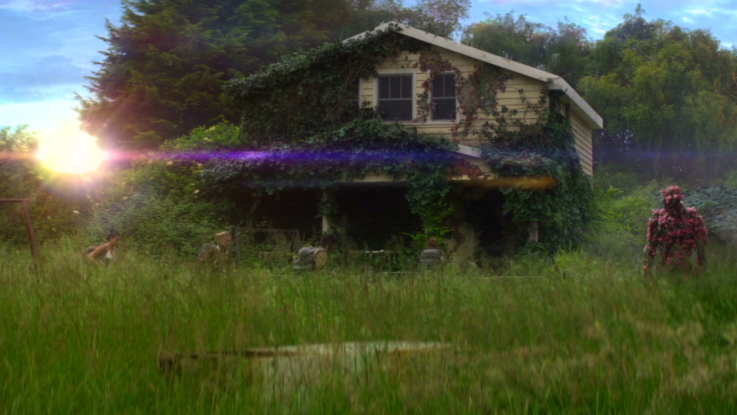
Cancer would seem to be merely a subset – the real theme here is destruction in a larger sense, both psychological and physical. If self-destruction is written into our cells, then The Shimmer and its endless refractions serve to hasten the realization of our own doomed genetic prophecy. In a truly strange way, the destructive forces rippling outward from the Lighthouse seem willing to grant the conscious and subconscious wishes of the people that draw near it.
At least, some of the time.
From her first scene in the film, Dr. Ventress exudes a profound apathy. This weariness, we find, comes from the knowledge of the cancer growing in her body. Of all the characters in the film, she is the one that you might say hopes for destruction – or at least has accepted it. If this is the case, her wish is granted at the Lighthouse, in the nerve center of the alien anomaly which is spreading inexorably outward. Her brief, surreal communion with whatever that thing is concludes with her brilliant and shocking annihilation. She goes to it willingly, and whatever it is that actually happened to her, the destruction of her physical self is undeniable.

Lena wants, by her own admission, to be with her husband. Her personal mission in entering The Shimmer is to find a way to get him out of his coma, and perhaps at the same time satisfy her own scientific curiosity as to what actually is happening inside that alien bubble. In a way, she too succeeds in her goal: she confronts the thing in the Lighthouse and apparently even manages to destroy it. But not before it changes her and destroys the Kane that she married. Like a wish granted by the monkey’s paw, she gets what she wanted, just not the way she wanted it.
And then there is Josie, the thoughtful physicist who recognized the scope of the alien refraction. She has a knack for seeing things the way they are. Shortly before her own mysterious fate, she and Lena discuss the way they are all changing as they draw near the source of the refractions.
“Ventress wants to face it,” she says. “You want to fight it. But I don’t think I want either of those things.”
Even as she is saying this, we see leaves sprouting out of her skin. In a matter of moments, perhaps even as she realizes what it is she wants, her genome is being rewritten to actualize her desire. This is the most immediate and astounding example of The Shimmer granting the self-destructive wish of a character. As Lena pursues her through some overgrowth, Josie disappears in a field of those humanoid plants which proved the key to her understanding the day before. Here is a character that struggled to “feel alive,” and through genetic refraction perhaps found a way to finally do just that.

The deaths of Cass and Anya are not nearly so gentle, or as satisfyingly symbolic. They are both killed violently by a mutant bear in some of the most nightmarish moments of the entire film. Even if we accept the premise that self-destruction is written into our cells, it is hard to believe that anyone would wish for the kind of ruin that befalls these two women. You could say that Anya died as she lived – impulsively, without much thought for the consequences of her actions. The others survived the bear by not reacting, but Anya’s character didn’t seem capable at any time of achieving that restraint.
Cass’ death seems even more senseless. The bear appears at night, seemingly out of nowhere, and snatches her away so quickly that her companions can’t fire a shot in retaliation. All they are left with are her screams, which come back to haunt them later.
If their deaths seem to fly in the face of the destructive wish-fulfillment theory, that may also be by design. Annihilation is not a simple allegory. Not everything that happens is a symbol meant to indicate something larger and more meaningful. Some things that happen in The Shimmer merely happen, just as they do in nature. That, as Dr. Ian Malcolm would say, is chaos. It is another way in which the film invites interpretation while purposefully eluding it – a bewildering trait which illustrates the sly genius of the film’s script while undoubtedly hurting the film’s overall popularity and box office success. Annihilation leads us into the jungle while carefully picking up the markers we’ve put down to help us find our way out. It is only when we are well and truly lost that the film’s full impact is felt.
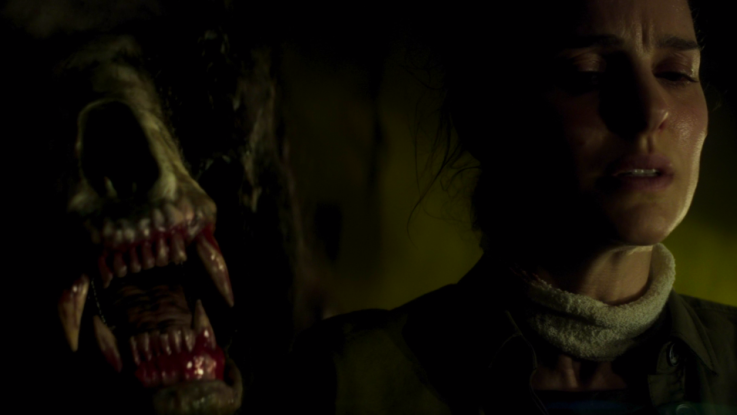
With the death of Cass there is at least a symbolic example of the film’s central and cyclical nature. If this is a movie about destruction, it is also necessarily one about creation. The mutated bear which destroys Cass rips out her vocal cords, and possibly more than that. In one of the more disquieting cinematic scenes in recent years, her fateful screams are heard out of the bear’s mouth when it returns to take the life of Anya. Josie even figures that part of Cass’ consciousness may have been absorbed by that ghastly creature.
This seems to border on the supernatural, but it does illustrate how life in The Shimmer (and nature, for that matter) is destroyed and repurposed. When Josie goes through her moment of self-destruction, her human body is ostensibly annihilated, but we understand that she lives on in a new form. Cancer itself destroys the host, but it does so through unchecked creation. In all of these cases, matter is not so much destroyed as it changed into something else.
The law of Conservation of Energy says that matter can be neither “created nor destroyed,” only transformed into new forms. So just as we cannot stop at cancer being the symbolic heart of this movie, neither can we stop at destruction. More accurately, this film is about the transformation that occurs, often beautifully and sometimes violently, in a system experiencing a new astronomical wrinkle.
The Shimmer, or whatever we want to call it, may represent something wholly foreign and even unknowable to humanity, but it would seem that it still obeys the first law of thermodynamics. Like Lena realizes in the aftermath: “It wasn’t destroying. It was changing everything. It was making something new.”

There is another symbolic detail in the film which encapsulates the theme of transformation through destruction. It is a tattoo, and it appears rather inexplicably on the forearms of Lena and Anya only after they have spent time in The Shimmer. It is also seen on the arm of an extremely dead soldier in an empty pool. The tattoo is a combination of two famous symbols: it is both the ouroboros (the snake that eats itself) and the mathematical symbol for eternity.
So in one symbol, both destruction and creation, transformation and infinity. Annihilation without end.

